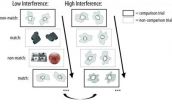(Press-News.org) October 12, 2012 – The human mouth is home to a teeming community of microbes, yet still relatively little is known about what determines the specific types of microorganisms that live there. Is it your genes that decide who lives in the microbial village, or is it your environment? In a study published online in Genome Research (www.genome.org), researchers have shown that environment plays a much larger role in determining oral microbiota than expected, a finding that sheds new light on a major factor in oral health.
Our oral microbiome begins to take shape as soon as we are born and sees a myriad of bacteria introduced to our mouth during childhood and later in life, yet little is known about whether nature (your genes) or nurture (your environment) has a stronger influence. Because of variations in the oral microbiome in both health and diseases like bacteremia and endocarditis, understanding the determinants of oral microbiota communities might lead to better prevention and treatment strategies.
In this study, a team of researchers from the University of Colorado sequenced the microbial DNA present in the saliva samples of a cohort of twins, and matched the DNA sequences in a database to determine which types of bacteria were present in each individual. In their data set, they utilized samples that were gathered over a decade of adolescence from the same individuals to observe how the salivary microbiome changes with time.
By comparing the salivary microbiomes of identical twins, who share the same genetic make-up and live in a common environment, the group found that their salivary microbiomes were not significantly more similar than the salivary microbiota of fraternal twins, who share only half of their genes, suggesting genetic relatedness is not as important as environment. "The conclusion that genetic relatedness plays at most only a small role in microbial relatedness was really a surprise," said Dr. Ken Krauter, senior author of the study.
"We were also intrigued to see that the microbiota of twin pairs becomes less similar once they moved apart from each other," added Simone Stahringer, first author of the study, explaining further evidence for the influence of environment on oral microbiota. Interestingly, in the samples obtained from the same individuals over time, they found that the salivary microbiome changed the most during early adolescence, between the ages of 12 and 17. This suggests that factors such as puberty or prominent behavioral changes at this age might be important.
Krauter explained that their work uncovered another unexpected finding, that there is a core community of bacteria that are present in nearly all humans studied. "Though there are definitely differences among different people, there is a relatively high degree of sharing similar microbial species in all human mouths."
The authors suggested that this report has established a framework for future studies of the factors that influence oral microbial communities. "With broad knowledge of the organisms to expect to find in mouths," said Krauter, "we can now better understand how oral hygiene, environmental exposure to substances like alcohol, methamphetamines and even foods we eat affect the balance of microbes."
###Scientists from the University of Colorado (Boulder, CO) contributed to this study.
This work was supported by the National Institutes of Health.
Media contacts:
The authors are available for more information by contacting Jim Scott, CU-Boulder Media Relations (jim.scott@colorado.edu, +1-303-492-3114).
Interested reporters may obtain copies of the manuscript via email from Peggy Calicchia, Administrative Assistant, Genome Research (calicchi@cshl.edu, +1-516-422-4012).
About the article:
The manuscript will be published online ahead of print on Friday, October 12, 2012. Its full citation is as follows:
Stahringer SS, Clemente JC, Corley RP, Hewitt J, Knights D, Walters WA, Knight R, Krauter KS. Nurture trumps nature in a longitudinal survey of salivary bacterial communities in twins from early adolescence to early adulthood. Genome Res doi: 10.1101/gr.140608.112.
About Genome Research:
Launched in 1995, Genome Research (www.genome.org) is an international, continuously published, peer-reviewed journal that focuses on research that provides novel insights into the genome biology of all organisms, including advances in genomic medicine. Among the topics considered by the journal are genome structure and function, comparative genomics, molecular evolution, genome-scale quantitative and population genetics, proteomics, epigenomics, and systems biology. The journal also features exciting gene discoveries and reports of cutting-edge computational biology and high-throughput methodologies.
About Cold Spring Harbor Laboratory Press:
Cold Spring Harbor Laboratory is a private, nonprofit institution in New York that conducts research in cancer and other life sciences and has a variety of educational programs. Its Press, originating in 1933, is the largest of the Laboratory's five education divisions and is a publisher of books, journals, and electronic media for scientists, students, and the general public.
Genome Research issues press releases to highlight significant research studies that are published in the journal.
In the bacterial world of your mouth, nurture wins out over nature
2012-10-12
ELSE PRESS RELEASES FROM THIS DATE:
Meteorite delivers Martian secrets to University of Alberta researcher
2012-10-12
(Edmonton) A meteorite that landed in the Moroccan desert 14 months ago is providing more information about Mars, the planet where it originated.
University of Alberta researcher Chris Herd helped in the study of the Tissint meteorite, in which traces of Mars' unique atmosphere are trapped.
"Our team matched traces of gases found inside the Tissint meteorite with samples of Mars' atmosphere collected in 1976 by Viking, NASA's Mars lander mission," said Herd.
Herd explained that 600 million years ago the meteorite started out as a fairly typical volcanic rock on the surface ...
Surprising solution to fly eye mystery
2012-10-12
Fly eyes have the fastest visual responses in the animal kingdom, but how they achieve this has long been an enigma. A new study shows that their rapid vision may be a result of their photoreceptors - specialised cells found in the retina - physically contracting in response to light. The mechanical force then generates electrical responses that are sent to the brain much faster than, for example, in our own eyes, where responses are generated using traditional chemical messengers. The study was published today, 12 October, in the journal Science.
It had been thought ...
Weizmann Institute Scientists observe quantum effects in cold chemistry
2012-10-12
At very low temperatures, close to absolute zero, chemical reactions may proceed at a much higher rate than classical chemistry says they should – because in this extreme chill, quantum effects enter the picture. A Weizmann Institute team has now confirmed this experimentally; their results would not only provide insight into processes in the intriguing quantum world in which particles act as waves, it might explain how chemical reactions occur in the vast frigid regions of interstellar space.
Long-standing predictions are that quantum effects should allow the formation ...
Developmental biologist proposes new theory of early animal evolution
2012-10-12
VALHALLA, October 11, 2012—A New York Medical College developmental biologist whose life's work has supported the theory of evolution has developed a concept that dramatically alters one of its basic assumptions—that survival is based on a change's functional advantage if it is to persist. Stuart A. Newman, Ph.D., professor of cell biology and anatomy, offers an alternative model in proposing that the origination of the structural motifs of animal form were actually predictable and relatively sudden, with abrupt morphological transformations favored during the early period ...
Alzheimer's sufferers may function better with less visual clutter
2012-10-12
TORONTO, ON – Psychologists at the University of Toronto and the Georgia Institute of Technology – commonly known as Georgia Tech – have shown that an individual's inability to recognize once-familiar faces and objects may have as much to do with difficulty perceiving their distinct features as it does with the capacity to recall from memory.
A study published in the October issue of Hippocampus suggests that memory impairments for people diagnosed with early stage Alzheimer's disease may in part be due to problems with determining the differences between similar objects. ...
Exercise helps ease premature cardiovascular aging caused by type 2 diabetes
2012-10-12
WESTMINSTER, CO (October 10, 2012)—One of life's certainties is that everyone ages. However, it's also certain that not everyone ages at the same rate. According to recent research being presented this week, the cardiovascular system of people with type 2 diabetes shows signs of aging significantly earlier than those without the disease. However, exercise can help to slow down this premature aging, bringing the aging of type 2 diabetes patients' cardiovascular systems closer to that of people without the disease, says researcher Amy Huebschmann of the University of Colorado ...
Exercise could fortify immune system against future cancers
2012-10-12
WESTMINSTER, CO (October 10, 2012)—Researchers may soon be able to add yet another item to the list of exercise's well-documented health benefits: A preliminary study suggests that when cancer survivors exercise for several weeks after they finish chemotherapy, their immune systems remodel themselves to become more effective, potentially fending off future incidences of cancer. The finding may help explain why exercise can significantly reduce the chances of secondary cancers in survivors or reduce the chances of cancer altogether in people who have never had the disease.
Laura ...
Parental bonding makes for happy, stable child
2012-10-12
Parents: Want to help ensure your children turn out to be happy and socially well adjusted? Bond with them when they are infants.
That's the message from a study by the University of Iowa, which found that infants who have a close, intimate relationship with a parent are less likely to be troubled, aggressive or experience other emotional and behavioral problems when they reach school age. Surprisingly, the researchers found that a young child needs to feel particularly secure with only one parent to reap the benefits of stable emotions and behavior, and that being attached ...
Minutes of hard exercise can lead to all-day calorie burn
2012-10-12
WESTMINSTER, CO (October 10, 2012)—Time spent in the drudgery of strenuous exercise is a well-documented turn-off for many people who want to get in better shape. In a new study, researchers show that exercisers can burn as many as 200 extra calories in as little as 2.5 minutes of concentrated effort a day—as long as they intersperse longer periods of easy recovery in a practice known as sprint interval training. The finding could make exercise more manageable for would-be fitness buffs by cramming truly intense efforts into as little as 25 minutes.
Kyle Sevits, Garrett ...
Focus on space debris: Envisat
2012-10-12
Space debris came into focus last week at the International Astronautical Congress in Naples, Italy. Envisat, ESA's largest Earth observation satellite, ended its mission last spring and was a subject of major interest in the Space Debris and Legal session.
Envisat was planned and designed in 1987, a time when space debris was not considered to be a serious problem and before the existence of mitigation guidelines, established by the UN in 2007 and adopted the next year by ESA for all of its projects.
Only later, during the post-launch operational phase, did Envisat's ...


